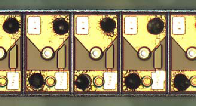Smart Optics Systems programme (Funding: STW Perspectief)
Waveguide-based External-Cavity Semi-conductor Laser arrays
| Applicants: |
Prof. Klaus Boller (University of Twente, project leader) Prof. J.L. Herek (University of Twente) Prof. Michel Verhaegen (TU Delft) |
| Partners: | XIO Photonics |
| Researchers: | Dr. Ruud Oldenbeuving (University of Twente) Dr. Hong Song (TU Delft, moved to Zhejiang University, China) Temitope Agbana (TU Delft) |
|

2D array of Waveguide-based External-Cavity Semi-conductor Laser arrays.
| |
| Project outline: |
The need to intensify the exchange of information with higher-speed (internet), the wish to display received information in most brilliant (Laser TV) colors, and most advanced techniques in bio-medical diagnostics, surprisingly, have their common grounds. When looking at their technological heart, one finds that it is the excellence in laser light generation that fosters their potential and growth. As a result there is a strong need to realize highly miniaturized lasers with greatly improved wavelength control, and at most affordable cost. In this project we investigate a novel approach that promises to fulfil many of these demands. For the first time, we use special (vertical cavity) diode lasers (VCSELs) and control their emission with a network of adjustable photonic wires (waveguides) made in a glass-chip. The design of these planar glass-based waveguide ring resonator circuits is that they can tune or lock the laser wavelength at will, via chip-integrated thermo-optical actuators, while at the same time allowing on-chip measurement of the wavelength. Stable operation, at any desired wavelength, is then done via a so-called smart controller. This is eventually a miniaturized electronic control chip, in which the most advanced control theory is applied for proper functioning of the laser and low cost. The described design allows further unprecedented possibilities; To scale-up the output power, entire arrays of diode lasers can be operated on the same waveguide chip. Mutual coupling combines their output into a single beam, e.g., as highly repetitive light pulses, enabling an easy and efficient conversion into powerful visible light for display purposes. |